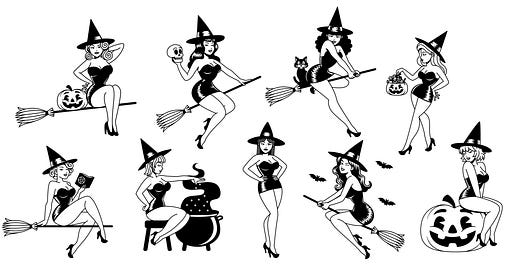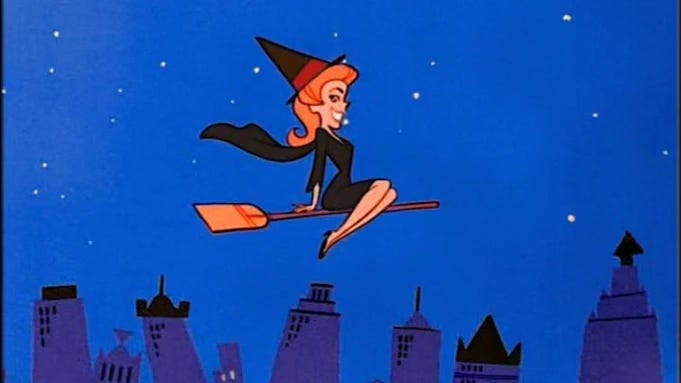Bewitched, Bothered, and Bewildered by love this October?
A dive into the heart-wrenching song that has become a Halloween staple.
With each holiday comes decorations, baked goods, and my favorite... playlists. The leaves have rusted like the splotch on an old Datsun, and the freshness of pumpkin is beginning to fade. Halloween is less than a week away, so the cynics can finally tighten their salted mouths about it being too early to decide whether you want to be a pirate or a black swan.
Attempting to get into the jovial spirit of Halloween, I immediately searched Halloween and Autumn playlists on Spotify. From “Monster Mash” to “Jeepers Creepers,” one song froze me, making the pumpkin pie taste artificial. A song I had known for a long time. A song I had forgotten was included in the mishmash of October songs. One of the most thought-provoking, best-written songs of all time.
"Bewitched, Bothered, and Bewildered"—lyrics by Lorenz Hart and music by Richard Rodgers.
Most of you are familiar with this song and have heard it at least once around Halloween. At first glance, the title may seem like it involves witchcraft, fitting the bill exquisitely for these sorts of playlists. Listen closely, and you’ll realize this seven-minute ballad performed by Ella Fitzgerald is horrifying- but not in the way you think.
Originally featured in the 1940 Broadway musical Pal Joey, this anthem of unrequited love seamlessly takes the listener through the erratic feelings of a tumultuous relationship. First played by Vivienne Segal, Vera is a wealthy socialite who gets seduced by a lounge singer into funding his nightclub. To understand the full plot, I recommend the 1957 movie starring Rita Hayworth as Vera and Frank Sinatra as Joey, but I am not here to focus on the musical as much as I am here to champion the beauty and depth of the songwriting.
The opening lines in the preamble set up an enchanting scene of how awakened, purified, and healed the soul can feel when falling in love, essentially curing everything (including the singer’s should-be hangover from all that brandy). She goes on to call this love interest a “half-pint imitation,” displaying the fact she is aware that her level of disarray over this underwhelming character is unreasonable. Hart masterfully captures the unexplainable experience of falling head over heels for someone as if spellbound.
"I'm wild again, beguiled again.
A simpering, whimpering child again."
The three lines that follow contradict themselves to the point of so much confusion that there is clarity: “Bewitched, Bothered, and Bewildered am I.”
The song describes the singer's inability to sleep or eat or maintain any control over her body. It wavers between a seamless dance of belittling the cold man she loves and belittling herself for recklessly disregarding her own well-being. The desperation in the first part of the song reflects how we crash our heart into another’s, thinking we have insurance that can cover the problem later.
Pictured below: Vivienne Segal & Gene Kelly in original Broadway show Pal Joey.
Fun Fact: The original lyrics showcase the singer’s naughtiness and abandonment of responsibility in pursuit of lust, a common theme in the early stages of new, often trivial relationships.
Ella Fitzgerald version:
"Couldn't sleep and wouldn't sleep
When love came and told me, I shouldn't sleep."Original Hart lyrics:
"Couldn’t sleep and wouldn’t sleep
Until I could sleep where I shouldn’t sleep."
As the song continues, the insinuations get stronger, and her longing intensifies. At first, she mentions how she longs for the day when she can cling to him and towards the end, the lyrics shift to her worshipping the trousers that cling to him. The feelings of love being a cycle of sadness and foolishness is sandwiched between these two contrasting desires, explaining how the idealism of the soul is lost and replaced with desperation for flesh at the very least.
This song is a pendulum of bliss and disappointment, as the one-sided love torments the singer while her love interest remains emotionally distant and vague. The sadness of this draining romance is intensified by the lack of conviction the love interest has in the singer.
"When he talks, he is seeking words to get off his chest."
The lyrics continue to compare the vehement love the singer has and the surface-leveled muse. The growing awareness of only a physical connection and not an emotional one makes the emptiness more known as the song progresses. Amplifying the depth of distraught, the blissful and freeing melody stirs the pot of confusion all the more.
From the progression of a pure, inexplicable love and denial of lust, to the acceptance of superficiality and unreturned feelings, the final part of this ballad wraps up the realistic relationship in a 500 Days of Summer or Blue Valentine type of “love” story.
Ironically, the song celebrates the empowerment found in becoming jaded. The fact that this was written in 1940 by Rodgers and Hart and remains one of the rawest portrayals of womanhood in love is remarkable. With its cinematic, tragic writing and composition, the song crescendos as wisdom dawns: the once idolized figure is finally cut down to size.
After this comes a beautiful transition into a reflective period, where the roles shift, and she feels nothing but sterility towards this person. The comedic, brash tone of this song creates such a strong character arc, arguably just as rich as that of a novel.
"Burned a lot, but learned a lot
And now you are broke, so you earned a lot."
So next time you hear a festive song that rattles your eardrum, listen carefully and cautiously because it may be The Challenger Deep and not The Caney Fork. I’ll leave you with the final verse, and may you not be bewitched, bothered, and bewildered this Halloween.
"Romance, finis;
your chance, finis
Those ants that invaded my pants, finis
Bewitched, bothered, and bewildered - no more."
Leave a comment if you’d like to see more articles like this ;)
Happy Halloween!










